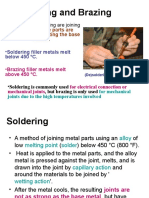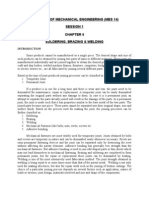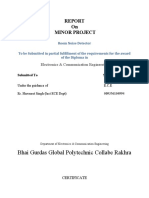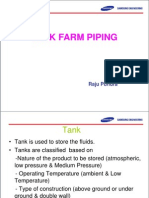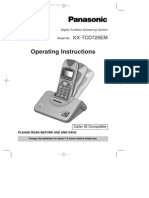Soldering - TLE
Soldering - TLE
Uploaded by
Lady StaAnaCopyright:
Available Formats
Soldering - TLE
Soldering - TLE
Uploaded by
Lady StaAnaCopyright
Available Formats
Share this document
Did you find this document useful?
Is this content inappropriate?
Copyright:
Available Formats
Soldering - TLE
Soldering - TLE
Uploaded by
Lady StaAnaCopyright:
Available Formats
Soldering is a process in which two or more metal items are joined together by melting and flowing a filler metal
(solder) into the joint, the filler metal having a lower melting point than the adjoining metal. Soldering differs from welding in that soldering does not involve melting the work pieces. In brazing, the filler metal melts at a higher temperature, but the work piece metal does not melt. In the past, nearly all solders contained lead, but environmental concerns have increasingly dictated use of lead-free alloys for electronics and plumbing purposes. Soldering Application Soldering is used in plumbing, electronics, and metalwork from flashing to jewelry. Soldering provides reasonably permanent but reversible connections between copper pipes in plumbing systems as well as joints in sheet metal objects such as food cans, roof flashing, rain gutters and automobile radiators. Jewelry components, machine tools and some refrigeration and plumbing components are often assembled and repaired by the higher temperature silver soldering process. Small mechanical parts are often soldered or brazed as well. Soldering is also used to join leadcame and copper foil in stained glass work. It can also be used as a semipermanent patch for a leak in a container or cooking vessel. Electronic soldering connects electrical wiring and electronic components to printed circuit boards (PCBs). Steps in Soldering Tinning The Soldering Tip Before use, a new soldering tip, or one that is very dirty, must be tinned. "Tinning" is the process of coating a soldering tip with a thin coat of solder. This aids in heat transfer between the tip and the component you are soldering, and also gives the solder a base from which to flow from. Step 1: Warm Up The Iron Warm up the soldering iron or gun thoroughly. Make sure that it has fully come to temperature because you are about to melt a lot of solder on it. This is especially important if the iron is new because it may have been packed with some kind of coating to prevent corrosion. Step 2: Prepare A Little Space While the soldering iron is warming up, prepare a little space to work. Moisten a little sponge and place it in the base of your soldering iron stand or in a dish close by. Lay down a piece of cardboard in case you drip solder (you probably will) and make sure you have room to work comfortably. Step 3: Thoroughly Coat The Tip In Solder Thoroughly coat the soldering tip in solder. It is very important to cover the entire tip. You will use a considerable amount of solder during this process and it will drip, so be ready. If you leave any part of the tip uncovered it will tend to collect flux residue and will not conduct heat very well, so run the solder up and down the tip and completely around it to totally cover it in molten solder. Tinning the iron with solder Step 4: Clean The Soldering Tip After you are certain that the tip is totally coated in solder, wipe the tip off on the wet sponge to remove all the flux residue. Do this immediately so there is no time for the flux to dry out and solidify.
Cleaning off excess solder and flux Step 5: You're Done! You have just tinned your soldering tip. This must be done anytime you replace the tip or clean it so that the iron maintains good heat transfer. Soldering Equipment The Soldering Iron/Gun The first thing you will need is a soldering iron, which is the heat source used to melt solder. Irons of the 15W to 30W range are good for most electronics/printed circuit board work. Anything higher in wattage and you risk damaging either the component or the board. If you intend to solder heavy components and thick wire, then you will want to invest in an iron of higher wattage (40W and above) or one of the large soldering guns. The main difference between an iron and a gun is that an iron is pencil shaped and designed with a pinpoint heat source for precise work, while a gun is in a familiar gun shape with a large high wattage tip heated by flowing electrical current directly through it. For hobbyist electronics use, a soldering iron is generally the tool of choice as its small tip and low heat capacity is suited for printed circuit board work (such as assembling kits). A soldering gun is generally used in heavy duty soldering such as joining heavy gauge wires, soldering brackets to a chassis or stained glass work. Solder The choice of solder is also important. There several kinds of solder available but only a few are suitable for electronics work. Most importantly, you will only use rosin core solder. Acid core solder is common in hardware stores and home improvement stores, but meant for soldering copper plumbing pipes and not electronic circuits. If acid core solder is used on electronics, the acid will destroy the traces on the printed circuit board and erode the component leads. It can also form a conductive layer leading to shorts. Desoldering Used solder contains some of the dissolved base metals and is unsuitable for reuse in making new joints. Once the solder's capacity for the base metal has been achieved it will no longer properly bond with the base metal, usually resulting in a brittle cold solder joint with a crystalline appearance. It is good practice to remove solder from a joint prior to resolderingdesoldering braids or vacuum desoldering equipment (solder suckers) can be used. Desoldering wicks contain plenty of flux that will lift the contamination from the copper trace and any device leads that are present. This will leave a bright, shiny, clean junction to be resoldered. The lower melting point of solder means it can be melted away from the base metal, leaving it mostly intact, though the outer layer will be "tinned" with solder. Flux will remain which can easily be removed by abrasive or chemical processes. This tinned layer will allow solder to flow into a new joint, resulting in a new joint, as well as making the new solder flow very quickly and easily.
You might also like
- Iot SRSDocument18 pagesIot SRSNimit JainNo ratings yet
- Soldering TutorialDocument15 pagesSoldering Tutorialyrikki100% (1)
- Soldering Guide FINAL 13 PPDocument13 pagesSoldering Guide FINAL 13 PPJean GrandeNo ratings yet
- Soldering electronic circuits: Beginner's guideFrom EverandSoldering electronic circuits: Beginner's guideRating: 4.5 out of 5 stars4.5/5 (9)
- Mathematical Elements For Computer Graphics 2nd Edition by David F Rogers J Alan Adams 0070535302 PDFDocument5 pagesMathematical Elements For Computer Graphics 2nd Edition by David F Rogers J Alan Adams 0070535302 PDFpriyanka yedage0% (2)
- How To Solder: Soldering Equipment The Soldering Iron/GunDocument16 pagesHow To Solder: Soldering Equipment The Soldering Iron/GunCool VermaNo ratings yet
- Soldering (BEE 2105)Document30 pagesSoldering (BEE 2105)Praise Jeshua JohnsNo ratings yet
- Assemble Information SheetDocument18 pagesAssemble Information SheetLeon AtsilegnaveNo ratings yet
- The Art and Science of Soldering: How We Do SolderingDocument3 pagesThe Art and Science of Soldering: How We Do SolderingchchuanNo ratings yet
- Soldering Equipment: How To Solder - Soldering TutorialDocument7 pagesSoldering Equipment: How To Solder - Soldering TutorialAnonymous f6goFflg3TNo ratings yet
- ECE 106L Experiment 7doneDocument8 pagesECE 106L Experiment 7doneslafaalysayyNo ratings yet
- SolderingDocument4 pagesSolderingv sharvan kumar asst.prof(mech)No ratings yet
- Robotics SolderingDocument3 pagesRobotics SolderingLaurice CabotajeNo ratings yet
- SolderingDocument7 pagesSolderingjitendrakitawatNo ratings yet
- Manuale Saldatura WellerDocument0 pagesManuale Saldatura WellerTorero CamomilloNo ratings yet
- Experiment 5 (Soldering)Document9 pagesExperiment 5 (Soldering)laibazafar1111No ratings yet
- Basic SolderingDocument7 pagesBasic SolderingJohn Paolo AlvarezNo ratings yet
- Microproject Group List Ej 1i A Basic WorkshopDocument14 pagesMicroproject Group List Ej 1i A Basic WorkshopTanishq MudaliarNo ratings yet
- Soldering Basic GuideDocument6 pagesSoldering Basic GuidechchuanNo ratings yet
- Group 8 Act3Document15 pagesGroup 8 Act3Joseph JeremyNo ratings yet
- Introduction To SolderingDocument3 pagesIntroduction To SolderingIisha_Chan_299No ratings yet
- 11 SolderingDocument11 pages11 SolderingrameshNo ratings yet
- Soldering and Des Older Ing ToolsDocument5 pagesSoldering and Des Older Ing ToolsRoyal SteevenNo ratings yet
- 10 LAS WEEk4Document4 pages10 LAS WEEk4Jenelyn RusianaNo ratings yet
- Group 2 Cpe479Document35 pagesGroup 2 Cpe479Azike valentineNo ratings yet
- How To Solder Beginners GuideDocument17 pagesHow To Solder Beginners GuideGustavo Guto67% (3)
- Soldering March IntakeDocument49 pagesSoldering March IntakeoriverbmwasotemwasoteNo ratings yet
- BASIC ELECTRICITY (Recovered)Document31 pagesBASIC ELECTRICITY (Recovered)judith abamaNo ratings yet
- How To Solder ElectronicsDocument6 pagesHow To Solder ElectronicsjackNo ratings yet
- Soldering Electronic Components 2nd EditionFrom EverandSoldering Electronic Components 2nd EditionRating: 3 out of 5 stars3/5 (2)
- Soldering TipsDocument14 pagesSoldering TipsFelimar CalaNo ratings yet
- Selecting The Right Soldering IronDocument4 pagesSelecting The Right Soldering IronHow EverNo ratings yet
- Basics of SolderingDocument4 pagesBasics of SolderingNAIR KRISHNA RAVEENDRAN100% (2)
- Soldering ToolsDocument7 pagesSoldering ToolsThamilselvan VengatasalamNo ratings yet
- How To Solder: What Is Soldering?Document11 pagesHow To Solder: What Is Soldering?Olive Joy GallemaNo ratings yet
- Soldering NotesDocument7 pagesSoldering NotesAlfred Galea100% (1)
- Agricultural Technology GR 10 Term 2 Week 8Document7 pagesAgricultural Technology GR 10 Term 2 Week 8louis.clensieNo ratings yet
- Agricultural Technology GR 10 Term 2 Week 9Document6 pagesAgricultural Technology GR 10 Term 2 Week 9louis.clensieNo ratings yet
- 15 Soldering Brazing and RivetingDocument39 pages15 Soldering Brazing and RivetingAyush50% (2)
- Welding WeldingDocument10 pagesWelding WeldingaakankshaNo ratings yet
- Soldering & Brazing Tools and EquipmentDocument5 pagesSoldering & Brazing Tools and Equipmentdchouhan72004No ratings yet
- CPE479 PresentationDocument25 pagesCPE479 Presentationanyanwujustice27No ratings yet
- Soldering PrectiDocument12 pagesSoldering PrectiDhaval V BhatasanaNo ratings yet
- Soldering and Desoldering TechniquesDocument29 pagesSoldering and Desoldering TechniquesJEAN RANCES RANIDO0% (1)
- New Microsoft Word DocumentDocument8 pagesNew Microsoft Word DocumentAshok GodarNo ratings yet
- LabInstr EE221L Lab5Document7 pagesLabInstr EE221L Lab5frebytony2006No ratings yet
- Soldering: Navigation SearchDocument12 pagesSoldering: Navigation SearchMarlon BoucaudNo ratings yet
- SolderingDocument58 pagesSolderingursamitnaik100% (1)
- Experiment No 4Document3 pagesExperiment No 4M IRFANNo ratings yet
- SolderingDocument6 pagesSolderingAnil KumarNo ratings yet
- Basic Welding TermsDocument43 pagesBasic Welding TermsmailbkraoNo ratings yet
- A Complete Guide On How To Solder ElectronicsDocument8 pagesA Complete Guide On How To Solder ElectronicsjackNo ratings yet
- BME Joining ProcessesDocument11 pagesBME Joining ProcessesalysonmicheaalaNo ratings yet
- Hot Solder Dip Prevents RustDocument4 pagesHot Solder Dip Prevents RustDaoud MiourighNo ratings yet
- Soldering TechniqueDocument23 pagesSoldering TechniquemokongNo ratings yet
- Soldring MechineDocument16 pagesSoldring MechinePrabir Kumar Pati100% (1)
- Experiment 2Document5 pagesExperiment 2frebytony2006No ratings yet
- CADWELD Frequently Asked QuestionsDocument2 pagesCADWELD Frequently Asked QuestionsAlejandro ArroyaveNo ratings yet
- Project Report On Room Noise DetectorDocument31 pagesProject Report On Room Noise DetectorSubhash Verma0% (1)
- 7.2 Soldering: Sngce Ece DeptDocument5 pages7.2 Soldering: Sngce Ece DeptSai KiranNo ratings yet
- Soldering Principles-WPS OfficeDocument5 pagesSoldering Principles-WPS OfficeChristopher GalivoNo ratings yet
- Swan Jkm385-405m-72h-Tv-A3,1 (2) - En-F30 PDFDocument2 pagesSwan Jkm385-405m-72h-Tv-A3,1 (2) - En-F30 PDFAndres Libardo Botero BoteroNo ratings yet
- Urban Assignment 2Document22 pagesUrban Assignment 2api-413335890No ratings yet
- 4.4 Mounting VESDA Pipe Network Installation Guide.Document40 pages4.4 Mounting VESDA Pipe Network Installation Guide.Eduardo Parrudo100% (1)
- Characteristics of G.M.Counter by MR - CharisDocument4 pagesCharacteristics of G.M.Counter by MR - CharisCharis Israel Ancha100% (4)
- UniGear ZS1 - Manual - EN - 1YHA000317 - REV C 08-2021Document56 pagesUniGear ZS1 - Manual - EN - 1YHA000317 - REV C 08-2021Reginaldo FerSoNo ratings yet
- UntitledDocument370 pagesUntitledbrahim nasriNo ratings yet
- JacobiDocument2 pagesJacobiHasbi Ashidiqi PNo ratings yet
- Storage Tank Farm PipingDocument33 pagesStorage Tank Farm PipingMarimuthu Ayyamperumal100% (4)
- 2010 02e 04 PDFDocument1 page2010 02e 04 PDFEidelsayedNo ratings yet
- PEM Self ClinchingDocument32 pagesPEM Self ClinchingArjun PanditNo ratings yet
- GD&T Symbols - GD&T Terms - Geometric Dimensioning and Tolerancing Glossary - GD&T Free ResourceDocument5 pagesGD&T Symbols - GD&T Terms - Geometric Dimensioning and Tolerancing Glossary - GD&T Free Resourcebbbsample0% (1)
- Latihan SoalDocument12 pagesLatihan SoalHaris Ahong SvenNo ratings yet
- Amtek Training Report 3 NewDocument73 pagesAmtek Training Report 3 NewjonyNo ratings yet
- Catalogo Usa UkDocument16 pagesCatalogo Usa UkXiong ChwNo ratings yet
- Ravintsara: Cinnamomum Camphora 5 MLDocument1 pageRavintsara: Cinnamomum Camphora 5 MLMonica SanduNo ratings yet
- Flowact: High Performance ActuatorDocument16 pagesFlowact: High Performance ActuatorJAntonio De la CruzNo ratings yet
- Summary Tasks: Notes/Table/ Flow Chart Completion: With Megan YucelDocument17 pagesSummary Tasks: Notes/Table/ Flow Chart Completion: With Megan YucelRose EvaNo ratings yet
- Literature Review of Earth Leakage Circuit BreakerDocument7 pagesLiterature Review of Earth Leakage Circuit BreakerequnruwgfNo ratings yet
- Fatima On-Site Report - Retrofit SA 5 To SAIQ - SP1905016 FATIMAFERT PDFDocument6 pagesFatima On-Site Report - Retrofit SA 5 To SAIQ - SP1905016 FATIMAFERT PDFB Lal MughalNo ratings yet
- SAPUI5 TrainingDocument148 pagesSAPUI5 TrainingikaNo ratings yet
- Cat RadiatorsDocument4 pagesCat RadiatorsRobert HutapeaNo ratings yet
- ASTM StandardsDocument27 pagesASTM StandardsTran Thanh Hao100% (2)
- Grip Systems Catalog Inch 2012Document389 pagesGrip Systems Catalog Inch 2012Casey100% (1)
- Panasonic KX-TCD 725 EDocument100 pagesPanasonic KX-TCD 725 EAleksandarRistićNo ratings yet
- Datasheet: - NI 9230 - NI 9230 Getting Started Guide Kit ContentsDocument18 pagesDatasheet: - NI 9230 - NI 9230 Getting Started Guide Kit ContentsGilbertoAndresDuarteNo ratings yet
- BlahDocument1 pageBlahGerry Mark GubantesNo ratings yet
- Spesifikasi Multix Impact C (High Throughput)Document1 pageSpesifikasi Multix Impact C (High Throughput)Radiologi RSUD KilisuciNo ratings yet
- NemichandDocument473 pagesNemichandNEMI CHAND SOODNo ratings yet







































